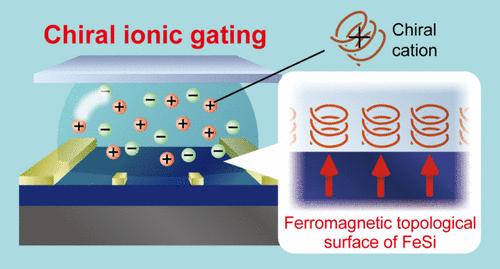手性离子门控二维铁磁特性的电场控制
IF 9.1
1区 材料科学
Q1 CHEMISTRY, MULTIDISCIPLINARY
引用次数: 0
摘要
手性分子系统提供了独特的途径来控制自旋和磁性超越传统的对称操作。在这里,我们证明了手性离子液体通过电双层晶体管门控实现了FeSi(111)薄膜中二维(2D)铁磁性的电场调制。FeSi具有化学稳定、表面受限的铁磁性,没有体矩,使得界面自旋对手性离子吸附具有高度响应。采用非手性和手性离子液体,系统地比较了电化学和静电门效应。虽然两种门控模式都可以调制磁性,如异常霍尔电导率和矫顽力场,但只有手性离子门控会以手性依赖的方式偏置上下磁化畴的比例,证明手性诱导的对称性破缺。本研究确立了手性离子门控作为控制磁序的新策略,为手性自旋电子学开辟了新的研究方向。本文章由计算机程序翻译,如有差异,请以英文原文为准。

Electric-Field Control of Two-Dimensional Ferromagnetic Properties by Chiral Ionic Gating
Chiral molecular systems offer unique pathways to control spin and magnetism beyond conventional symmetry operations. Here, we demonstrate that chiral ionic liquids enable the electric-field modulation of two-dimensional (2D) ferromagnetism in FeSi(111) thin films via electric double-layer transistor gating. FeSi hosts chemically stable, surface-confined ferromagnetism without bulk moments, making the interfacial spins highly responsive to chiral-ion adsorption. Using both achiral and chiral ionic liquids, we systematically compare the electrochemical and electrostatic gating effects. While both gating modes modulate magnetic properties such as anomalous Hall conductivity and coercive field, only chiral ionic gating biases the ratio of up- and downmagnetized domains in a handedness-dependent manner, evidencing chirality-induced symmetry breaking. This work establishes chiral ion gating as a novel strategy for controlling magnetic order and opens new directions for chiral spintronics.
求助全文
通过发布文献求助,成功后即可免费获取论文全文。
去求助
来源期刊

Nano Letters
工程技术-材料科学:综合
CiteScore
16.80
自引率
2.80%
发文量
1182
审稿时长
1.4 months
期刊介绍:
Nano Letters serves as a dynamic platform for promptly disseminating original results in fundamental, applied, and emerging research across all facets of nanoscience and nanotechnology. A pivotal criterion for inclusion within Nano Letters is the convergence of at least two different areas or disciplines, ensuring a rich interdisciplinary scope. The journal is dedicated to fostering exploration in diverse areas, including:
- Experimental and theoretical findings on physical, chemical, and biological phenomena at the nanoscale
- Synthesis, characterization, and processing of organic, inorganic, polymer, and hybrid nanomaterials through physical, chemical, and biological methodologies
- Modeling and simulation of synthetic, assembly, and interaction processes
- Realization of integrated nanostructures and nano-engineered devices exhibiting advanced performance
- Applications of nanoscale materials in living and environmental systems
Nano Letters is committed to advancing and showcasing groundbreaking research that intersects various domains, fostering innovation and collaboration in the ever-evolving field of nanoscience and nanotechnology.
 求助内容:
求助内容: 应助结果提醒方式:
应助结果提醒方式:


